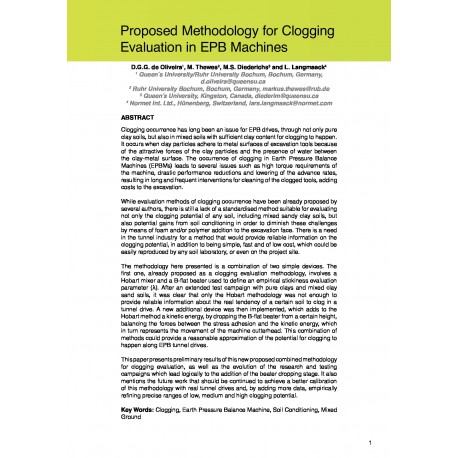Cart
0
0
No document
0,00 €
Total
Document successfully added to your shopping cart
Quantity
Total
There are 0 items in your cart.
There is 1 item in your cart.
Total documents
Total shipping
To be determined
Total
Search & filter
Search for a publication
Search & filter
Viewed documents

Proposed Methodology for Clogging Evaluation in EPB Machines
1333_proposed_methodology_for_cl
M. Thewes / M. S. Diederichs / L. Langmaack / D. G. G. de Oliveira
Clogging occurrence has long been an issue for EPB drives, through not only pure clay soils, but also in mixed soils with sufficient clay content for clogging to happen. It occurs when clay particles adhere to metal surfaces of excavation tools because of the attractive forces of the clay particles and the presence of water between the clay-metal surface. The occurrence of clogging in Earth Pressure Balance Machines (EPBMs) leads to several issues such as high torque requirements of the machine, drastic performance reductions and lowering of the advance rates, resulting in long and frequent interventions for cleaning of the clogged tools, adding costs to the excavation. While evaluation methods of clogging occurrence have been already proposed by several authors, there is still a lack of a standardised method suitable for evaluating not only the clogging potential of any soil, including mixed sandy clay soils, but also potential gains from soil conditioning in order to diminish these challenges by means of foam and/or polymer addition to the excavation face. There is a need in the tunnel industry for a method that would provide reliable information on the clogging potential, in addition to being simple, fast and of low cost, which could be easily reproduced by any soil laboratory, or even on the project site. The methodology here presented is a combination of two simple devices. The first one, already proposed as a clogging evaluation methodology, involves a Hobart mixer and a B-flat beater used to define an empirical stickiness evaluation parameter (λ). After an extended test campaign with pure clays and mixed clay sand soils, it was clear that only the Hobart methodology was not enough to provide reliable information about the real tendency of a certain soil to clog in a tunnel drive. A new additional device was then implemented, which adds to the Hobart method a kinetic energy, by dropping the B-flat beater from a certain height, balancing the forces between the stress adhesion and the kinetic energy, which in turn represents the movement of the machine cutterhead. This combination of methods could provide a reasonable approximation of the potential for clogging to happen along EPB tunnel drives. This paper presents preliminary results of this new proposed combined methodology for clogging evaluation, as well as the evolution of the research and testing campaigns which lead logically to the addition of the beater dropping stage.


